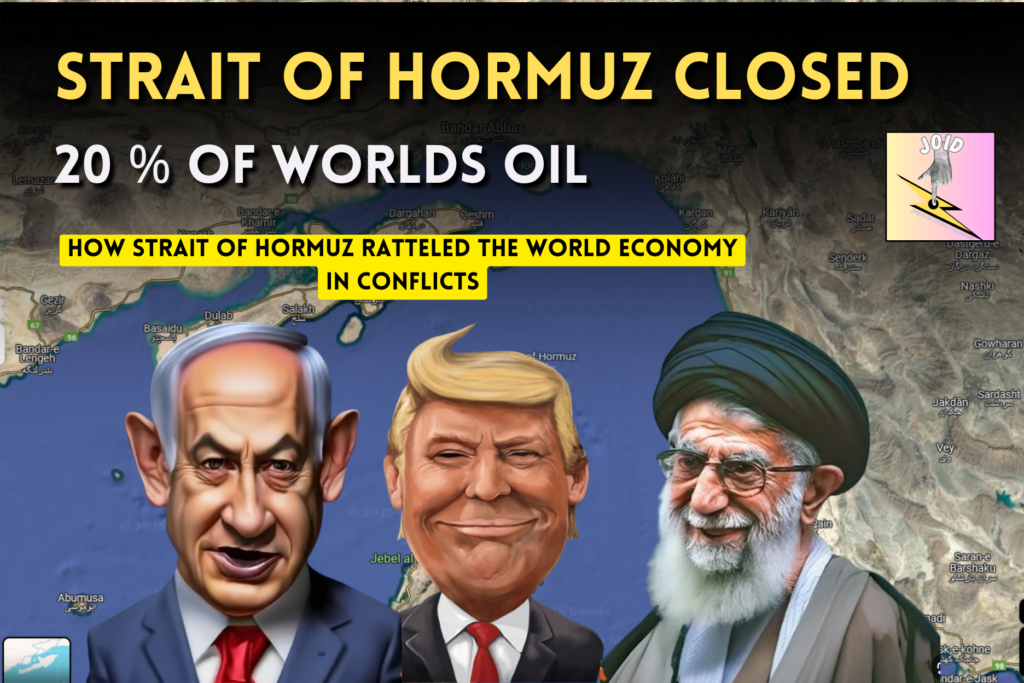
Title: Iran’s Strait Gamble: If Hormuz Shuts, How Hard Will India and the World Be Hit?
Strait of Hormuz: Where Oil and Geopolitics Collide
This weekend has been a nightmare for all the investors throughout the world , global markets is set to be trembled once more as Iran’s parliament has approved a symbolic resolution to close the Strait of Hormuz, one of the most crucial arteries of global energy supply. Though it is not the final call of Parliament it depends on the Iran’s Supreme National Security Council, the mere news of it sent a quake in crude market as crude prices surging and triggered urgent recalculations across oil-dependent economies. For India, which receives over a third of its oil imports through this narrow passageway, is enough to put a wrinkle on investors forhead.
What historical data tells us
Strait of Hormuz has precariously been a fulcrum of geopolitical tension. Accepting the fact that it never fully closed, it has witnessed sufficient maritime skirmishes, tanker wars, and threats to create a tension in oil markets.
- 1980s Tanker War: During the Iran-Iraq conflict, over 400 ships were attacked. Oil prices spiked by 25%, and the U.S. Navy began escorting tankers to stabilize flows.
- 2011-2012 Threats: Iran threatened closure in retaliation for sanctions. Oil surged briefly but stabilized as military deterrents took position.
- 2019 Tanker Attacks: Four ships, including two Saudi tankers, were damaged near the UAE. Insurance premiums spiked, but oil stayed below $75 as diplomacy held.
World’s reaction on it and Economical Impact
In most of all similar instances, global markets reacted with sharp, short-lived volatility. Market have seen jump often in Crude prices nearly 10–20% in the first 48 hours of a crisis. Stocks particularly in oil-consuming economies fall 1–2%, while defense stocks and commodities like gold rally.
In most cases, markets correct within a few weeks. As Goldman Sachs analysts noted in 2022, “Oil shocks from geopolitical events generally is short-term unless accompanied by a true supply collapse.”
June 2025: Market Ripples Begin
Brent crude surged 15% in a week to touch $91 a barrel following the Iranian resolution. India’s Sensex and Nifty dropped 1.3% intraday before recovering, with energy and defense stocks outperforming. The Indian rupee weakened slightly against the dollar as traders feared costlier imports.
Hardeep Singh Puri, India’s Petroleum Minister, assured Parliament that India had “enough strategic reserves for three weeks and diversified import sources,” yet admitted that prolonged closure would “jolt the economy.”
What a Real Closure Would Mean
If Iran were to genuinely block Hormuz—a move that experts argue is self-destructive—it would halt nearly 20 million barrels of oil per day. India, which imports about 5.5 million bpd, would lose up to 2 million bpd.
Prices could spike to $120–130 per barrel. Indian inflation, already hovering near the RBI’s upper band, would soar. Diesel and petrol prices could rise by Rs. 8–12 per litre. Fiscal policy tools, including excise duty cuts, would have to be deployed swiftly.
India’s Cushion—and Its Cracks
India has strategically tried to position itself in a safe palce and long ago it has diversified it’s oil imports to Russia, the U.S., and Latin America. LNG from Qatar also arrives via routes that bypass Hormuz. But the reality is that the Gulf remains irreplaceable in the short term. Saudi and Emirati pipelines offer only 2.6 million bpd of bypass capacity, and much of it is already committed.
India’s $600 billion in forex reserves and domestic oil subsidies provide a short-term shield. But a protracted crisis would force tough decisions on fuel taxes, subsidies, and current account management.
Panic or Pause / Experts opinion
Energy expert Vandana Hari of Vanda Insights believes, “Markets are pricing risk, not reality. A full closure is a last resort and would invite massive retaliation.” Others like JPMorgan warn that any accidental escalation could push oil past $110 and create a stagflationary spiral.
Domestic market strategists are cautiously optimistic. Kotak AMC’s Nilesh Shah stated, “India can absorb oil at $100; beyond that, consumer sentiment and corporate earnings will take a hit.”
Conclusion
Iran’s saber-rattling over the Strait of Hormuz is not just a diplomatic signal—it’s a shot across the bow of the global economy. For India, the risks are magnified by its import dependence and regional vulnerability.
Yet history offers cautious comfort. No matter how loud the threats, Hormuz has never truly closed. If markets hold onto that precedent, the current turbulence may be a storm India and the world can weather—unless this time really is different.
Our other articles : Bengal Bellwether – 2 | Bengal Bellwether – 1 | India United – India’s message is loud & clear on terrorism a diplomatic strike on terror| The Indian Stock Market is bleeding | SUPER NARI – 25 | Caste and the Ballot in Bihar | The suicidal mission of Pakistan’s so called ‘Establishment’ | Who is Responsible for Bihar’s Migration Crisis? | Why Congress must go solo in Bihar | Jai Bhim | Old is Gold , Resurrection of ‘Dynasty Politics’ | China Faces 125% Tariff by USA: A Strategic Opportunity for India | When the Accuser Becomes the Accused
